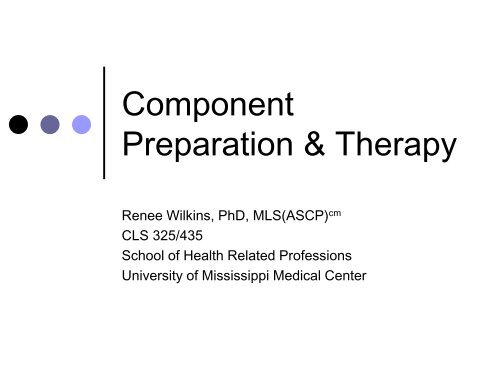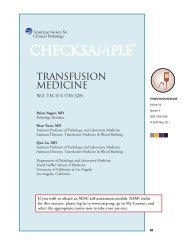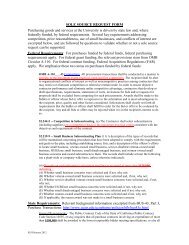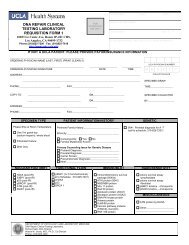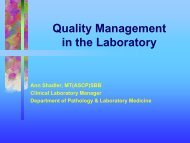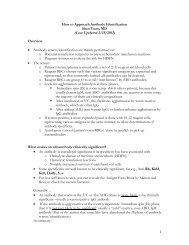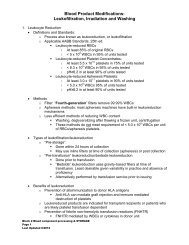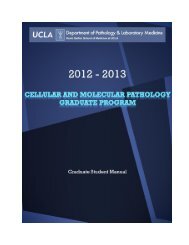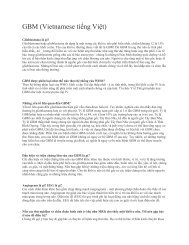Blood Component Preparation and Therapy. By Renee Wilkins, PhD ...
Blood Component Preparation and Therapy. By Renee Wilkins, PhD ...
Blood Component Preparation and Therapy. By Renee Wilkins, PhD ...
Create successful ePaper yourself
Turn your PDF publications into a flip-book with our unique Google optimized e-Paper software.
<strong>Component</strong><strong>Preparation</strong> & <strong>Therapy</strong><strong>Renee</strong> <strong>Wilkins</strong>, <strong>PhD</strong>, MLS(ASCP) cmCLS 325/435School of Health Related ProfessionsUniversity of Mississippi Medical Center
Basic <strong>Blood</strong> <strong>Component</strong>s Red <strong>Blood</strong> Cells Platelets Fresh Frozen Plasma (FFP) Cryoprecipitated Anti-hemophilicFactor Granulocytes
Terms to know: Whole blood: blood collected beforeseparation into components <strong>Component</strong>s: parts of whole bloodthat are separated Closed system: a sterile system ofblood collection Open system: when the collection isexposed to air, decreasing expirationdate
Collection basics <strong>Blood</strong> is collected in a primary bagthat contains anticoagulantpreservatives Satellite bags may also be attached,depending on what components areneeded Anticoagulant-preservatives minimizebiochemical changes <strong>and</strong> increaseshelf life
Na+K +PlasmahemoglobinPlasma K +Viable cellspHATP2,3-DPGPlasma Na +Helps release oxygenfrom hemoglobin (oncetransfused, ATP & 2,3-DPG return to normal)
<strong>Blood</strong> <strong>Component</strong><strong>Preparation</strong> <strong>Component</strong>s of whole blood arecentrifuged:• “light spin” – short time, low RPM• “heavy spin” – longer spin, high RPM• Procedures are in the AABB TechnicalManual
Centrifuged bloodPlasma/serumBuffy Coat(WBCs & Platelets)Red <strong>Blood</strong> Cells
Whole <strong>Blood</strong> <strong>Component</strong> Requirements• Stored: 1-6° C• Shipping: 1-10° C• 21 or 35 days depending onpreservative (CPD, CP2D, or CPDA-1)
Whole <strong>Blood</strong> Consists of RBCs, WBCs, platelets <strong>and</strong>plasma (with anticoagulant) 1 unit increases Hgb 1 g/dL <strong>and</strong> Hct 3% When is it used?• Patients who are actively bleeding <strong>and</strong>lost >25% of blood volume• Exchange transfusion
Red <strong>Blood</strong> Cells24hours RBCs• 1-6° C (stored); 1-10° C (shipped)• 21, 35, or 42 days depending onpreservative or additive• Hematocrit should be ≤80%• One unit increases hematocrit 3%• Once the unit is “opened” it has a24 hour expiration date!
Red <strong>Blood</strong> Cells RBCs (frozen)• ≤ -65°C for 10 years RBCs (deglycerolized or washed)• Good at 1-6°C for 24 hours RBCs (irradiated)• 1-6°C for 28 days
Red <strong>Blood</strong> Cells RBCs are usually given because oftheir hemoglobin content They increase the mass of circulatingred blood cells in situations whereblood loss occurs
RBCs Conditions include:• Oncology patients (chemo/radiation)• Trauma victims• Cardiac, orthopedic, <strong>and</strong> other surgery• End-stage renal disease• Premature infants• Sickle cell disease ( Hgb A)
RBC Types Leukocyte-Reduced RBCs are for:• patients who receive a lot oftransfusions to prevent antibodyproduction toward WBC antigens• Patients transfused outside of ahospital• Patients who have reacted toleukocytes in the past
LeukocyteReduction Filters(maintains closed system)http://www.pall.com/39378_39479.aspFinal unit must have lessthan 5 x 10 6 WBCs
RBC Types Frozen RBCs• Glycerol is added tocryoprotect the unit• Glycerol prevents celllysis• Why?• Freezing RBCspreserves rare units orextends to life ofautologous units
RBC Types Deglycerolized RBCs• RBCs that have had theglycerin removed• Thawed at 37°C• A blood cell processorwashes the cells with varyingconcentrations of saline• Considered “open”, expires in24 hrs.
RBC Types Washed RBCs• Not effective in reducing WBCs• For patients (with anti-IgA) that mayreact with plasma proteins containingIgA• Reactions may be allergic, febrile, oranaphylactic
RBC Types Irradiated RBCs• Prevents T-cell proliferation that may causetransfusion-associated graft versus hostdisease (GVHD)• GVHD is fatal in 90% of those affected• Used for:• Donor units from a blood relative• HLA-matched donor unit• Intrauterine transfusion• Immunodeficiency• Premature newborns• Chemotherapy <strong>and</strong> irradiation• Patients who received marrow or stem cells
Platelets Important in maintaining hemostasis Help stop bleeding <strong>and</strong> form a plateletplug (primary hemostasis) People who need platelets:• Cancer patients• Bone marrow recipients• Postoperative bleeding
How platelets are processed Requires 2 spins:• Soft – separates RBCs <strong>and</strong> WBCs fromplasma <strong>and</strong> platelets• Heavy• platelets in platelet rich plasma (PRP) willbe forced to the bottom of a satellite bag• 40-60 mL of plasma is expelled intoanother satellite bag, while the remainingbag contains platelet concentrate
<strong>Preparation</strong> of plateletconcentratePlasmaRBCsPRPPlateletconcentrate
Platelets Storage Temperature• 20-24°C for 5 days (constantagitation) Each unit should contain at least 5.5 x10 10 platelets (platelet concentrate) Each unit should elevate the plateletcount by 5-10,000 µL in a 165 lbperson
Types of platelets Pooled platelets• Used to reach therapeutic dose• An “open system” occurs when poolingplatelets, resulting in an expiration of 4 hours Platelet, pheresis – therapeutic dose (fromone donor) without having to pool platelets• 3x10 11 minumum• HLA matched – for those with HLAantibodies• Leukocyte reduced - used to prevent febrilenon-hemolytic reactions <strong>and</strong> HLAalloimmunization
Fresh Frozen Plasma (FFP) Plasma that is frozen within 8 hours ofdonation• -18°C or colder for 1 year Provides coagulation factors for• Bleeding• Abnormal clotting due to massive transfusion• Patients on warfarin who are bleeding• Treatment of TTP <strong>and</strong> HUS• Factor deficiencies• ATIII deficiency• DIC when fibrinogen is
Fresh Frozen Plasma FFP is thawed before transfusion• 30-37°C waterbath for 30-45 minutes• Stored 1-6°C <strong>and</strong> transfused within 24hours• Needs to be ABO compatible
Cryoprecipitate Cryoprecipitated antihemophilic factor(AHF) or “Cryo” is the precipitated proteinportion that results after thawing FFP Contains:• von Willebr<strong>and</strong>’s factor (plt. adhesion)• Fibrinogen• 150 mg in each unit• Factor VIII• About 80 IU in each unit• Fibrinonectin
Cryoprecipitate Same storage as FFP (cannot be re-frozen as FFPonce it is separated); -18 for 1 year If thawed, store at room temp 4 hrs The leftover plasma is called cryoprecipitatereduced or plasma cryo• Good for thrombocytopenic purpura (TTP) CRYO is used for• 2° treatment for Factor VIII deficiency (Hemophilia A)• 2 ° treatment for von Willebr<strong>and</strong>’s Disease• Congenital or acquired fibrinogen deficiency• FXIII deficiency• “Fibrin Glue” applied to surgical sites
Cryoprecipitate(VIII, vW)FFPThaw at 30-37°CStore at RT 4 hrsFrozenwithin 8hoursThawedFFPPlasma cryoprecipitate, reduced(TTP, FII, V, Vii, IX, X, XI)Refrozen with 24 hrs ofseparationStore at ≤18°C 1 yr5 day expiration at 1-6°C
GranulocytesLymphocyteMonocyteNeutrophils Eosinophils Basophils
Granulocytes Neutrophils are the most numerous,involved in phagocytosis ofbacteria/fungi Although rare, it is useful for infantswith bacteremia Prepared by hemapheresis ≥ 1.0 x 10 10 Maintained at room temp for 24 hours
Labeling of components ISBT labeling• International Society of <strong>Blood</strong>Transfusion recommendationsregarding the uniform labeling of loodproducts for international bar coderecognition by computers
ReferencesRudmann, S. V. (2005). Textbook of <strong>Blood</strong> Banking <strong>and</strong> TransfusionMedicine (2 nd Ed.). Philadelphia, PA: Elsevier Saunders.Blaney, K. D. <strong>and</strong> Howard, P. R. (2000). Basic & Applied Concepts ofImmunohematology. St. Louis, MO: Mosby, Inc.Flynn, J. C. (1998). Essentials of Immunohematology.


